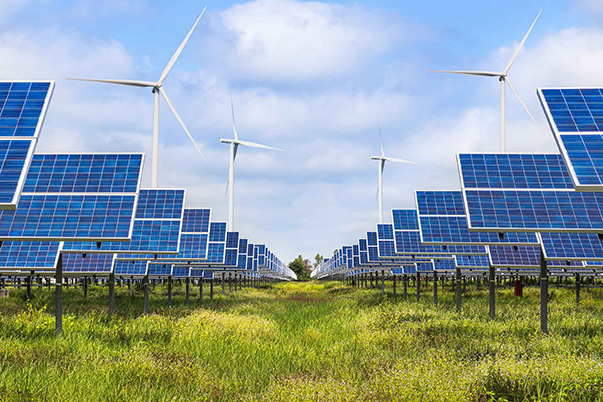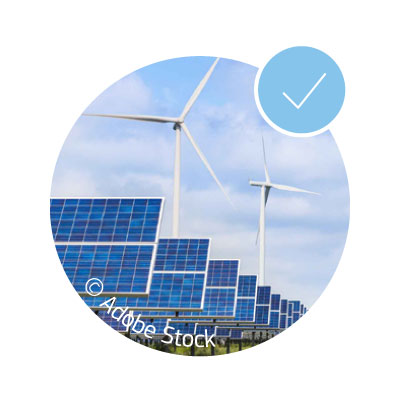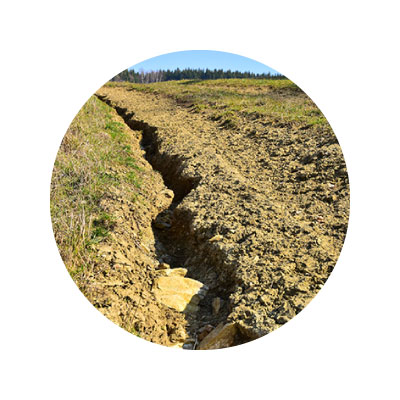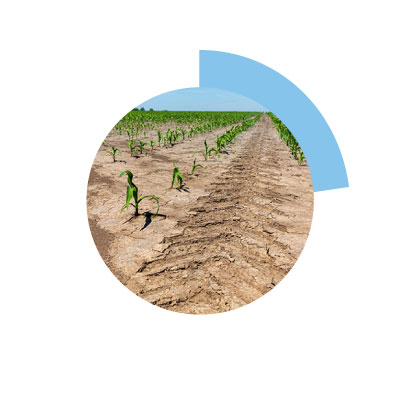
Chapter 3 – Creating a climate-neutral and prosperous Europe

Introduction
The European Green Deal is the European Union’s roadmap for tackling the threefold threat of the climate, environmental and biodiversity crises. With it, the EU raised the level of its climate ambitions by committing to reach climate neutrality by 2050. It is transforming the EU into a fair and prosperous society with a modern, resource-efficient and competitive economy.
In 2023, the EU reached an important milestone on its path towards achieving climate neutrality. The key legislation to meet – and even exceed – its midterm target of cutting net greenhouse-gas emissions by at least 55 % by 2030 was adopted in mid October.
Extreme weather once again exposed the harsh reality of climate change across the EU and the world, highlighting the need for continued efforts to cut emissions as quickly as possible. At COP28, the EU played a leading role in securing both a global agreement to accelerate the transition away from fossil fuels and a commitment to triple global renewable-energy capacity and double the rate of energy-efficiency improvements by 2030.
The reality of a boiling planet
The disruption and destruction brought by extreme weather events in Europe and the world in 2023 was a stark reminder of the grave and ever-present threat climate change poses to societies, and of the need for urgent action to protect the planet.
Dry conditions contributed to longer and more dangerous wildfire seasons, with large outbreaks as early as March in Spain, and record-breaking fires devastating parts of Greece, Spain and Portugal in July and August. The wildfire in Greece’s north-eastern region of Evros was the biggest the EU has ever seen. According to the European Forest Fire Information System - open a new tab., by 22 July more than 181 000 hectares of land across the EU had already been reduced to ashes - open a new tab. – more than 40 % above the average recorded between 2003 and 2022 (128 225 hectares).
In response to the increasing wildfire risk, in 2023 the EU strengthened its anticipatory and foresight capabilities, reinforced its rescEU firefighting fleet - open a new tab. and positioned hundreds of firefighters so they were able to provide immediate support. It also created a Wildfires Support Team as part of its Emergency Response Coordination Centre - open a new tab..
With 7 record-breaking months and two record-breaking seasons, 2023 was the world’s warmest year in recorded history. According to the EU’s Copernicus Climate Change Service - open a new tab., close to 50 % of the days in 2023 were more than 1.5 °C above the pre-industrial average (1850–1900).
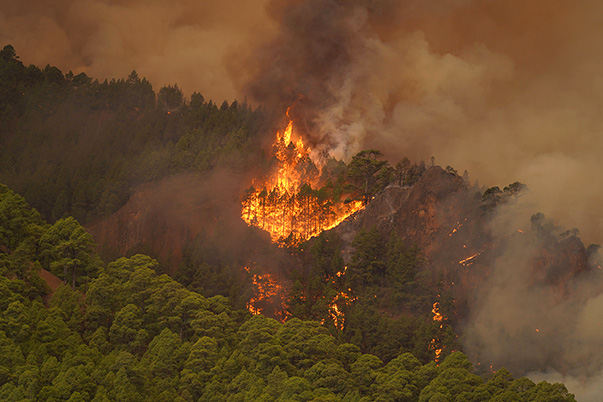
Wildfires are a global concern. To help tackle the worst wildfires in Canada in a decade (which burned around 4 million hectares, an area as big as the Netherlands), the EU Member States offered the services of around 300 firefighters to the country via the EU Civil Protection Mechanism - open a new tab. (see Chapter 8).
As a result of the unprecedented floods and forest fires, calls in 2023 for disaster recovery and reconstruction support from the European Union Solidarity Fund - open a new tab. mobilised all available resources to provide assistance.
Extreme rainfall caused deadly floods in parts of the EU, including Croatia, Italy, Austria and Slovenia.
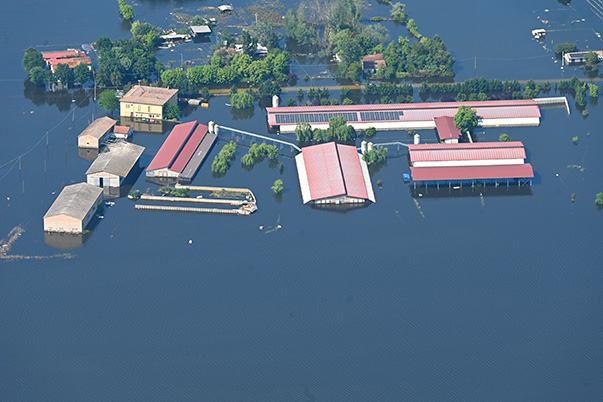
On 15 July, the EU inaugurated the annual Day for the Victims of the Global Climate Crisis - open a new tab., to commemorate victims in Europe and worldwide. The event aims to raise awareness of the specific steps that people can take to help reduce the damage caused by climate change and to be better prepared for climate disasters.
Beyond Europe, climate change is also a serious threat to the world’s poorest countries, aggravating pre-existing crises and requiring greater efforts to meet the rise in humanitarian needs (see Chapter 8). According to the UN Food and Agriculture Organization, the proportion of low- and middle-income countries exposed to climate extremes has increased from 76 % to 98 % over the last two decades.
Towards net zero
The UN Intergovernmental Panel on Climate Change report - open a new tab., released in March, once again saw the scientific community issue a stark warning about the need for action to tackle the climate crisis. The report reaffirms that the world is warming up rapidly due to human influence, with weather extremes and catastrophes putting lives and livelihoods at risk around the world. The science is clear: the only way to halt global warming and lessen the effects of climate change is by bringing greenhouse-gas emissions to net zero. This means achieving a balance between the amount of greenhouse-gas emissions released into the atmosphere and the amount removed from it.
Thanks to existing climate and energy legislation, the EU’s greenhouse-gas emissions have already fallen by 32.5 % compared to 1990, while the EU economy has grown by 60 % in the same period.
Making Europe the first climate-neutral continent is the cornerstone of the European Green Deal - open a new tab.. This objective is enshrined in the European Climate Law - open a new tab., alongside the legally binding commitment to reduce net greenhouse-gas emissions by at least 55 % by 2030, compared to 1990 levels.
To achieve this, in 2021 the European Commission presented the ‘fit for 55’ package of legislative proposals. In 2022, under the REPowerEU Plan - open a new tab., it raised the level of ambition of some of the proposals (notably those on energy efficiency - open a new tab. and renewable energy - open a new tab.) with a view to further reducing the EU’s dependence on imports of Russian fossil fuels (see Chapter 4). By the end of 2023, the key legislation to achieve the 2030 target of a 55 % net reduction was in place (see below). This includes legally binding targets covering all sectors of the economy, a target to boost natural carbon sinks and an updated EU Emissions Trading System - open a new tab..
More than 9 in 10 EU citizens consider climate change a serious problem.
Climate change is considered:
 a very serious problem by 77 %
a very serious problem by 77 % a fairly serious problem by 16 %
a fairly serious problem by 16 % not a serious problem by 7 %
not a serious problem by 7 %
Source: Special Eurobarometer 538 - open a new tab., July 2023.
The existing system was strengthened in 2023, and its scope was expanded to cover emissions from maritime transport. A separate new Emissions Trading System was created to extend carbon pricing to new sectors of the economy, in particular to fuels for buildings and road transport. In addition to putting a price on pollution and generating investment in the green transition, the new system will provide social support for people and small businesses to ensure no one is left behind.
The final legislative package is expected to reduce the EU’s net greenhouse-gas emissions by 57 % by 2030, compared to 1990.
A new mechanism - open a new tab. for importing goods from outside the EU will ensure that a carbon price is set in targeted sectors. New legislation also includes updated targets on renewables and energy efficiency, and rules to boost charging infrastructure and the use of alternative fuels in road transport, shipping and aviation.
In 2023, the Member States had to submit their updated draft national energy and climate plans - open a new tab., which outline how they intend to meet the EU’s energy and climate targets for 2030. In December, the Commission assessed the plans and issued recommendations.
Leaving no one behind
To ensure a fair and inclusive green transition, €55 billion will be generated in investment - open a new tab. over the current decade to support those living in the EU regions facing the greatest challenges in shifting to a climate-neutral economy. In cooperation with national, regional and local stakeholders, the EU is helping to diversify regional economies and give people the chance to thrive in the new economy (see also Chapter 6).
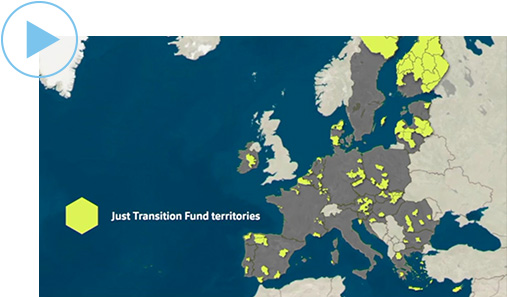
Fit for 55 – adopted legislation
The EU’s competitiveness will rely greatly on its capacity to develop and manufacture the clean technologies required for a successful transition to a net-zero economy. To strengthen the competitiveness of net-zero technologies in the EU and support the fast transition to climate neutrality, the Commission presented the Green Deal Industrial Plan for the Net-Zero Age - open a new tab. in February 2023. The plan aims to create a more supportive environment for scaling up the EU’s manufacturing capacity for net-zero technologies and products (see Chapter 4).
The EU is also supporting innovative net-zero technologies through the Innovation Fund - open a new tab., financed by the Emissions Trading System. It aims to bring solutions to the market to decarbonise European industry and support the transition to climate neutrality, while boosting the EU’s competitiveness. Some Member States are also supporting the manufacturing capacity of innovative technologies under their national recovery and resilience plans. The Commission has launched a series of Clean Transition Dialogues to be able to support every sector in building its business model for the decarbonisation of industry, starting with dialogues on hydrogen and energy-intensive industries in 2023 (see Chapter 4).
Towards a circular economy
During the year, the EU continued to make progress in moving towards a circular economy, with the aim of making sustainable products the norm, reducing pressure on natural resources, cutting waste and creating sustainable growth and jobs.
Every year, more than 5 million tonnes of clothing is discarded in the EU (over 11 kg per person), yet only 22 % of this waste is collected separately for reuse or recycling, while the remainder is often incinerated or sent for landfill. Proposed new rules - open a new tab. on textiles will hold producers accountable for the life cycles of their products, in particular waste management, thus promoting sustainable textile-waste handling across the EU. Increasing the availability of used and recycled textiles is expected to create local jobs and save money for consumers in the EU and beyond, while alleviating the impact of textile production on natural resources. The ReSet the Trend - open a new tab. campaign was launched in 2023 to raise awareness about sustainable fashion.
Food waste has a huge economic, social and environmental impact. Under a new proposal - open a new tab. presented by the Commission in July, Member States will be expected to reduce food waste - open a new tab. in processing and manufacturing by 10 % by 2030, and by 30 % (per capita) jointly at the retail and consumption levels. These new targets will benefit food security and cut greenhouse-gas emissions, while also saving costs for businesses and consumers.
58.4 million tonnes (131 kg/person/year) are generated annually in the EU. Source: Eurostat - open a new tab., 2023.
Approximately 10 % of all food supplied to retailers, food services and households is wasted.
Over half of food waste is generated by households (54 %).
The second-largest share (21 %) is from the processing and manufacturing sector.
Underpinning these efforts, the Commission has adopted a revised Circular Economy Monitoring Framework - open a new tab. to better track progress in the transition to a circular economy in the EU, and its contribution to global sustainability and EU resilience. This framework includes new indicators, such as the material footprint and resource productivity, to measure progress towards waste-prevention targets.
Every year, almost 6 million vehicles in the EU reach the end of their life. Inadequate end-of-life handling of vehicles results in lost value and pollution. Proposed new rules - open a new tab., which cover all aspects of a vehicle from its design and placement on the market to its final treatment, are expected to generate €1.8 billion in net revenue by 2035. They will also lead to significant carbon savings and reduced dependency on raw materials, and create additional jobs and enhanced revenue streams for the waste-management and recycling industry.
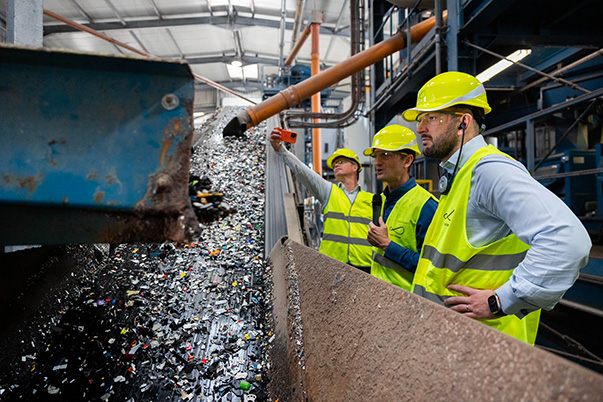
New measures to boost circularity in the automotive sector could lead to up to 4 million more cars being recycled and 22 000 more jobs by 2035.
A political agreement - open a new tab. was reached on the Commission’s proposal for new rules on waste shipments, which will ensure that the EU takes greater responsibility for its own waste. The export of plastic waste from the EU to countries that are not members of the Organisation for Economic Co-Operation and Development will be banned. The agreement will contribute to reducing waste pollution and advancing the circular economy.
Products have a significant environmental impact throughout their life cycle – from the extraction of raw materials to their manufacture, transport, use and end of life. In December, an agreement - open a new tab. was reached on the proposal to make sustainable products the norm in the EU. The new Ecodesign for Sustainable Products Regulation - open a new tab. builds on the existing ecodesign rules - open a new tab. that have successfully driven the improved energy efficiency of products in the EU for almost 20 years. The new law will extend the existing framework in two ways: first, to cover the broadest possible range of products; second, where appropriate, to broaden the scope of the requirements with which products must comply.
Empowering consumers for the green transition is an important element in achieving the sustainable-consumption objectives of the European Green Deal. The European Parliament and the Council of the European Union reached an agreement - open a new tab. in September on the proposal for new rules that will ensure that consumers are better informed about the durability and repairability of the goods they purchase, and better protected against unfair commercial practices. There will also be a new ban on misleading claims on products based on offsetting emissions. The Commission has also presented a proposal - open a new tab. to improve access to and information about repair services. This promotes repair over replacement during the legal guarantee and requires manufacturers to repair goods that are and will become subject to specific repairability (ecodesign) requirements under EU law.
Making sustainable choices
New rules - open a new tab. have been finalised to help consumers make informed and eco-friendly choices when buying mobile phones and tablets. New ecodesign rules will improve the durability, repairability, reusability and recyclability of such devices. Meanwhile, the new energy label on smartphones and tablets will detail their efficiency and durability, and a repairability score will guide consumers towards sustainable choices. The rules will apply from 20 June 2025.
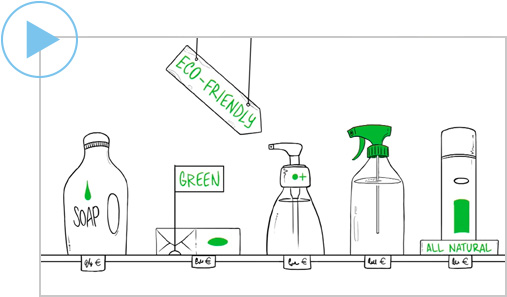
Advancing the Zero-Pollution Action Plan
Water
In 2023, with the revised Drinking Water - open a new tab. Directive having been incorporated into national legislation, new rules began to apply across the EU. These rules will ensure some of the highest standards in the world for drinking water.
In June, in response to evidence that there is now less rain in many parts of the EU, new requirements - open a new tab. for the safe reuse of treated wastewater in agricultural irrigation started to apply.
An EU report - open a new tab. analysing one of the largest ecological disasters in Europe in recent memory, in which around 360 tonnes of fish died in the Oder River, was published in February 2023. It identifies the likely cause as being a substantial toxic algal bloom, and proposes recommendations to help prevent such a catastrophic event from happening again.
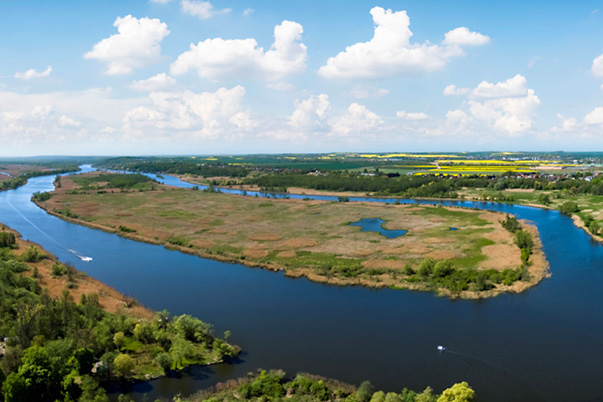
Although maritime safety in EU waters is very high, with few fatalities and no recent major oil spills, more than 2 000 marine accidents and incidents are still reported every year. In June, the Commission presented five legislative proposals - open a new tab. to modernise EU rules and prevent water pollution from ships. The proposals also aim to prevent illegal discharges into European seas in order to lower the environmental impact of maritime transport activities and preserve the marine ecosystem.
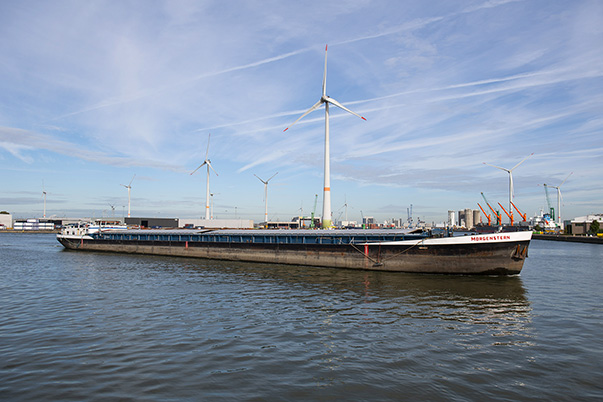
Increasing maritime safety
Stringent EU safety standards are effective, but new challenges
and technologies require new approaches.

Biodiversity
Nature is vital in combating climate change. The degradation of the natural environment increases the likelihood and severity of events such as floods and wildfires, making Europe’s nature and biodiversity its best defence against natural disasters.
A provisional political agreement was reached - open a new tab. in November on the Nature Restoration Law - open a new tab., setting in motion a process for the continuous and sustained recovery of nature. Member States will put restoration measures in place in at least 20 % of the EU’s land areas and 20 % of its seas by 2030. By 2050, such measures should be in place for all ecosystems that need restoration.
Soil
Healthy soils are crucial for ensuring food security, achieving climate neutrality and stopping desertification and land degradation. Yet over 60 % of European soils are unhealthy. The proposal for a soil monitoring law - open a new tab. aims to put the EU on a pathway to healthy soils by 2050 by gathering data on the health of soils and making it available to farmers and other soil managers. The new law will also make sustainable soil management the norm. The Commission has also published guidance on EU funding opportunities for healthy soil for stakeholders. The Mission Soil Manifesto - open a new tab., launched in April, brings together regional and local policymakers, stakeholders and citizens in a vibrant community that cares for soil health. More than 2 100 individuals and 350 organisations had signed up to the voluntary initiative by the end of the year. Signatories recognise the need for action on soil health and engage in activities for soil protection and restoration.
Pollinators
With one in three bee, butterfly and hoverfly species in the EU disappearing, the Commission presented a renewed initiative - open a new tab. in 2023 setting out action to be taken by the EU and the Member States to reverse the decline of pollinators by 2030. Citizens have increasingly been calling for decisive action against pollinator loss, most recently through the successful European Citizens’ Initiative ‘Save Bees and Farmers - open a new tab.’. The EU also lowered - open a new tab. the maximum residue levels of two neonicotinoid pesticides in food to the lowest level that can be measured with the latest technologies. The outdoor use of clothianidin - open a new tab. and thiamethoxam - open a new tab. has already been banned in the EU. The new levels will apply to food and feed products produced in or imported into the EU. This will ensure that food placed on the internal market does not contribute to the decline of pollinators, regardless of where it is produced.
Soil health directly affects EU food security

Forests
Forests are a crucial ally in the fight against climate change and biodiversity loss. The extent to which land, and the land-use sector in particular, can contribute to climate mitigation depends largely on how these areas are used and managed. Carbon removal in the EU land-use sector has decreased significantly in recent years, and the land-sink function is in decline. In 2023, the EU upgraded its legislation - open a new tab. on land use, land-use change and forestry to boost carbon removal and promote sustainable agricultural and forest land management.
In November, the Commission proposed - open a new tab. a forest monitoring law that aims to create a comprehensive knowledge base that will allow Member States, forest owners and forest managers to improve their response to the growing pressures on forests, which are exacerbated by climate change. As well as ensuring forests are more resilient to cross-border threats (pests, drought and wildfires), the monitoring framework will help forest owners and managers benefit from ecosystem payment schemes such as the EU carbon removal certification scheme.
The pioneering EU Regulation on Deforestation-free Supply Chains - open a new tab., a key building block in the fight against climate change and biodiversity loss, entered into force in June. Operators and traders will have 18 months to implement the new rules. Once applied, they will ensure that a set of key goods exported from the EU or placed on the EU market will no longer contribute to deforestation and forest degradation, either in the European Union itself or elsewhere in the world. The list includes palm oil, coffee, soy and chocolate. The new rules will also help secure the livelihoods of millions of people, including indigenous peoples and local communities across the world, who rely heavily on forest ecosystems.
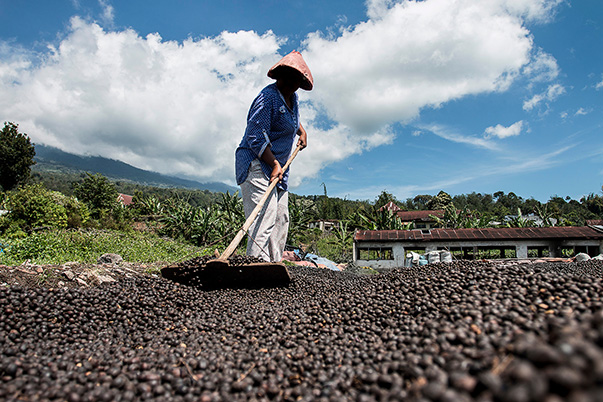
Sustainable food systems
The approval of all 28 strategic plans - PDF file, open a new tab. by the Commission marked the start of the new Common Agricultural Policy - open a new tab. (CAP) on 1 January 2023. A total of €264 billion of EU funding will support European farmers in the transition towards a more sustainable and resilient agricultural sector and help preserve the vitality and the diversity of rural areas between 2023 and 2027. Close to €98 billion will be devoted to delivering benefits for the climate, water, soil, air, biodiversity and animal welfare, in line with the objectives of the European Green Deal.
The new CAP will contribute to EU objectives on reducing the use of and risk from chemical pesticides and will substantially increase targeted support for organic farming. It will also provide incentives to land managers to store carbon in soil and biomass and to reduce greenhouse-gas emissions in 35 % of the EU’s agricultural area through appropriate management practices, with crop rotation expected on 85 % of CAP-supported arable land.
At a time of growing concerns about food supply, the Commission continued its work on mapping the drivers of food security. A new proposal - open a new tab. to enable the safe use of new genomic techniques - open a new tab. will contribute to the advance towards more sustainable food systems while safeguarding food security. These techniques can create climate-resilient, pest-resistant and high-yielding plant varieties, reducing the need for chemical pesticides and the EU’s reliance on agricultural imports. The Commission has proposed new EU legislation - open a new tab. on the production and marketing of plant and forest reproductive material to increase the diversity and quality of seeds, cuttings and other plant material.
The CAP is not only a tool to support recovery and restoration measures after a crisis; it also enables farmers to anticipate and adapt to the effects of climate change and other challenges. The EU is looking into how best to support EU farmers, and how to adapt EU agriculture policies with their needs in mind. To deliver on this, the Strategic Dialogue on the Future of EU Agriculture will be launched in January 2024.
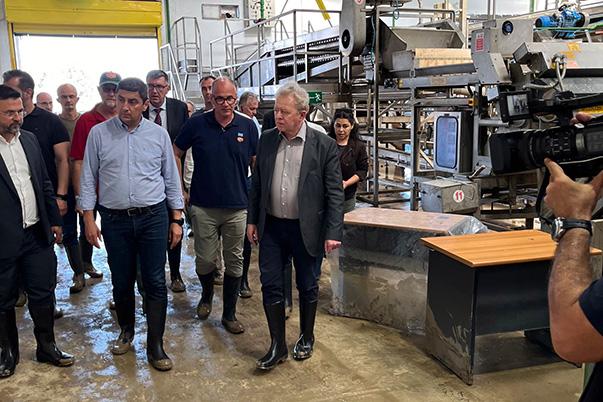
Animal welfare
The EU has been acting to improve animal welfare for over 40 years, progressively making the lives of animals better and adopting welfare standards that are among the highest in the world. This continued in 2023 with a proposal - open a new tab. to overhaul the current EU rules on transporting animals, which will improve the well-being of the 1.6 billion animals transported within and from the EU each year. The proposal focuses on specific objectives, including reducing travel times, increasing minimum space allowances and improving conditions for animals exported from the EU. The enforcement of existing legislation remains a priority, and regular audits and controls continued during 2023 in various areas.
In addition, the first-ever rules on the welfare and traceability of dogs and cats - open a new tab. will establish uniform EU standards for the breeding, housing and handling of dogs and cats in breeding establishments, pet shops and shelters. The traceability of dogs and cats will also be reinforced through mandatory identification and registration in national databases to fight illegal trading, and will allow for better control of the welfare conditions in such establishments.
The Commission responded during the year to the European Citizens’ Initiative ‘Fur Free Europe - open a new tab.’ – the 10th successful initiative, supported by over 1.5 million citizens across the EU. While no further legislation is proposed at this stage, the Commission envisages a series of measures to address the aims of the initiative, including tasking the European Food Safety Authority with preparing a scientific opinion on the welfare of fur animals by March 2025.
Further measures on animal welfare, for example the follow-up to the ‘End of Cage’ European Citizens’ Initiative, are under preparation.
What do people in the EU have to say about animal welfare?
Sustainable fisheries and oceans
Climate change and biodiversity loss threaten the sustainability of fisheries and aquaculture resources. A package of measures - open a new tab. put forward in February sets out measures to tackle these challenges through the implementation of the Common Fisheries Policy - open a new tab. and a new Marine Action plan - open a new tab.. The measures provide ways to increase the resilience and sustainability of fisheries and aquaculture, including by supporting the much-needed energy transition (see Chapter 4). The package contributes to the EU’s commitment to protect at least 30 % of its seas (with 10 % under strict protection). The proposed measures will be carried out gradually to enable the sector to adapt.
New rules - open a new tab. adopted by the Parliament and the Council in 2023 aim to help prevent overfishing and create a more effective and harmonised fisheries control system, taking full advantage of modern technologies. This includes the use of remote electronic monitoring and CCTV on board fishing vessels, and the mandatory use of digital tools in catch certification and traceability processes to prevent imports obtained from illegal fishing.
The Commission welcomed the European Citizens’ Initiative ‘Stop Finning – Stop the trade - open a new tab.’, which asked it to help end the international trade in loose shark fins, starting with banning the trade on the EU market. The Commission will consider whether legislation is necessary. It will also step up the enforcement of EU traceability measures and engage with international partners to protect and sustainably manage sharks globally.
After more than a decade of multilateral negotiations, the High Seas Treaty - open a new tab. was adopted in June. This treaty is a historic achievement in efforts to protect the ocean, tackle environmental degradation, fight climate change and prevent biodiversity loss in the high seas. It has been a priority for the EU and its Member States, which led the negotiations - open a new tab. at the global level. The treaty will enter into force once it has been ratified by 60 parties.
The EU formally accepted - open a new tab. the World Trade Organization Agreement on Fisheries Subsidies on behalf of its Member States. The agreement is crucial for ensuring that fisheries subsidies have sustainability as their core objective and avoid harming the ocean and fish stocks, on which the livelihoods of coastal communities around the world depend. It will enter into force once two thirds of the 164 members of the organisation have completed their domestic ratification processes.
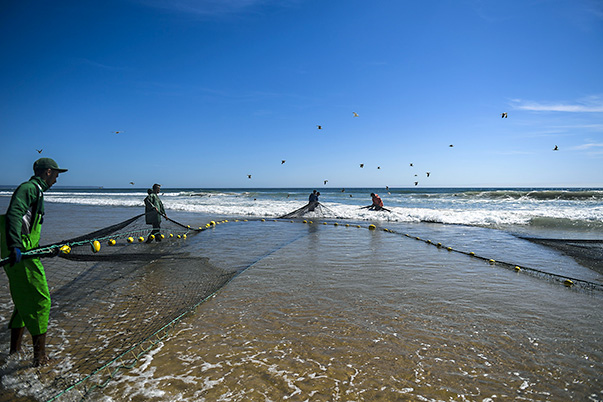
Sustainable mobility
The EU is investing in a wide range of transport projects to improve cross-border infrastructure and promote new technologies through the 2021–2027 Connecting Europe Facility - open a new tab.. Projects that received EU funding in 2023 - open a new tab. include major cross-border rail connections, notably the Brenner Base Tunnel (linking Italy and Austria), Rail Baltica (connecting the three Baltic states and Poland with the rest of Europe) and the cross-border section between Germany and the Netherlands (Emmerich–Oberhausen). The €6.2 billion worth of funding supports projects contributing to a more efficient, greener and smarter network of railways, inland waterways, roads and maritime routes, with the majority going to sustainable transport modes. To improve cross-border rail connections across Europe, the EU announced support in 2023 for 10 EU pilot projects - open a new tab. establishing new rail services or improving existing ones – making them faster, more frequent and more affordable.
In addition, the EU invested over €540 million in alternative-fuel infrastructure along the Trans-European Transport Network. This will translate into approximately 14 000 charging points and 81 hydrogen refuelling stations, along with the electrification of ports and airports.
The EU also proposed - open a new tab. to revise its Combined Transport Directive - open a new tab., with the aim of making freight transport more sustainable by improving the competitiveness of using two or more transport modes.
The Commission has put forward a revision of the standards for carbon dioxide emissions from heavy-duty vehicles - open a new tab. such as trucks, city buses and long-distance buses. These are responsible for over 25 % of greenhouse-gas emissions from road transport in the EU and over 6 % of total EU emissions. To stimulate faster deployment of zero-emission buses in cities, the Commission proposed to make all new city buses zero-emission as of 2030.
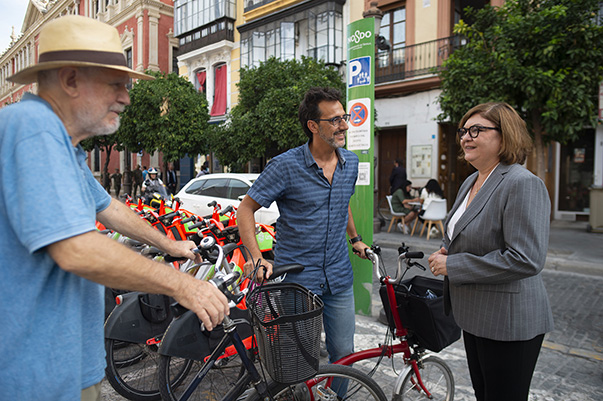
Acting globally for the planet
The 2023 UN Climate Change Conference (COP28 - open a new tab.) in Dubai, United Arab Emirates, marked the conclusion of the first global stocktake under the Paris Agreement - open a new tab. to see how much progress countries have made since the adoption of the global agreement on climate change.
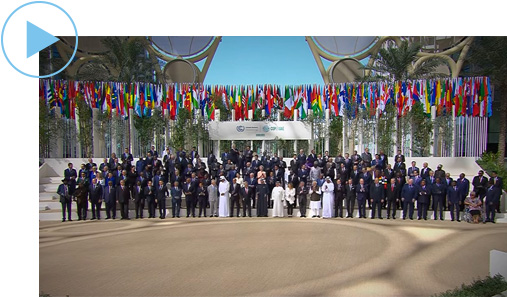
The EU succeeded, with partners from around the world, in keeping alive the possibility of delivering on the commitment made in Paris in 2015 to limit the global average temperature increase to 1.5 °C. Recognising that the world is not currently on track to reach this goal, the parties agreed a pathway to get back on course.
All parties agreed to transition away from fossil fuels and to take urgent action in this critical decade for the climate. With the talks having a particular focus on the energy sector, countries agreed to take action to reduce emissions by 43 % by 2030 and to set the world on a path to reaching net-zero emissions by 2050, in line with the best available science.
The EU led a global initiative at the conference to triple global renewable energy capacity and double the rate of energy-efficiency improvements by 2030, launching the Global Pledge on Renewables and Energy Efficiency - open a new tab. during the talks. With the support of the COP28 presidency, and backed by some 130 countries, the pledge was endorsed by the entire world in the conference outcome document, the ‘UAE Consensus - open a new tab.’.
The EU announced it would invest €2.3 billion from the EU budget to support the energy transition in the European Neighbourhood and around the globe in the next 2 years, through the Global Gateway - open a new tab. strategy (see Chapter 8).
Under the Global Methane Pledge - open a new tab., launched by the EU and the United States in 2021, more than 150 countries are now implementing a collective goal to reduce global methane emissions by at least 30 % below 2020 levels by 2030. At COP28, the EU and its Member States announced funding of €175 million in support of the Methane Finance Sprint - open a new tab. to boost methane reduction.
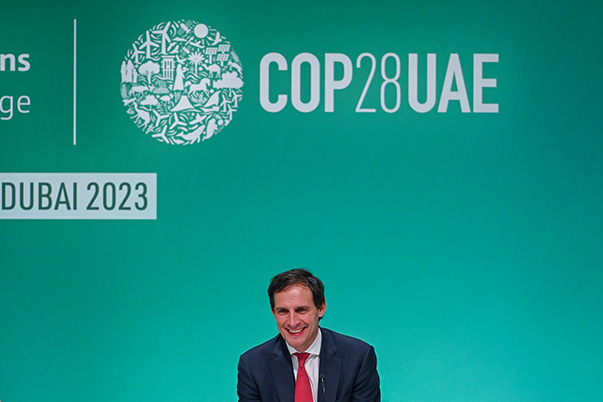
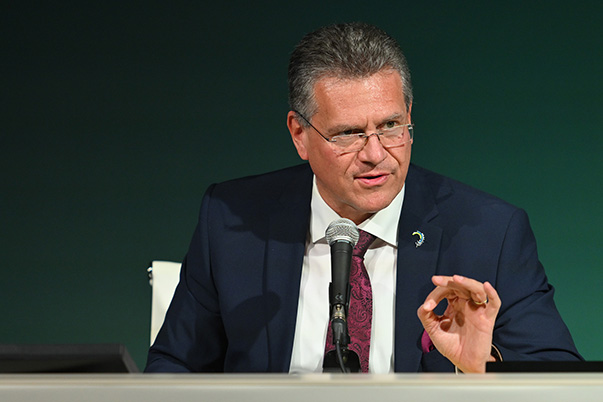
The global stocktake also addressed the means of implementing the necessary transition, with parties agreeing on the final steps towards setting the new collective quantified goal on climate finance at next year’s conference. A framework for the Global Goal on Adaptation - open a new tab., which aims to strengthen the world’s resilience to climate change, was also agreed at the conference.
The EU helped to operationalise the new Loss and Damage Fund, which will assist developing countries that are particularly vulnerable to the adverse effects of climate change. The EU and its Member States contributed more than €400 million to the fund – over two thirds of the initial funding pledges.
To address the human impact of the climate crisis in fragile and conflict settings, the EU joined two new flagship initiatives launched by the COP28 presidency: Getting Ahead of Disasters: A charter on finance for managing risks - open a new tab. and the Declaration on Climate, Relief, Recovery and Peace - PDF file, open a new tab.. The charter sets out principles to ensure better use of finance to manage risks and protect people in the most vulnerable countries, while the declaration calls for urgent financial support for climate adaptation and resilience in those countries.
At the UN Water Conference - open a new tab. in March, the first summit of its kind in almost 50 years, the EU confirmed its strong commitment - open a new tab. to ensuring global water resilience and security. The EU delegation presented - PDF file, open a new tab. 33 voluntary commitments to the Water Action Agenda - open a new tab., a platform to accelerate global progress on the water-related Sustainable Development Goals.
At the start of the year, the EU partnered with 26 countries to launch the Coalition of Trade Ministers on Climate - open a new tab., the first ministerial-level global forum dedicated to trade, climate and sustainable development issues. The coalition aims to drive trade policies that address climate change both locally and globally.
The EU forged a green alliance with Norway - open a new tab. in April, and another with Canada - open a new tab. in November, to deepen cooperation on the climate, the environment, energy and clean industry. The EU and South Korea also established a green partnership - open a new tab. in May, with the aim of strengthening cooperation and exchanging best practices on climate action, a clean and fair energy transition, protection of the environment and other fields of the green transition.
Sustainable Development Goals
The first voluntary review - PDF file, open a new tab. by the EU on the implementation of the 2030 Agenda for Sustainable Development shows that it is fully committed to delivering the 17 Sustainable Development Goals, which were adopted by all UN member states in 2015.
The EU has firmly placed sustainable development at its core, and is making efforts to advance the 2030 Agenda both at home and around the world by supporting partner countries in their implementation efforts.
The EU has integrated the goals into its policies, budgets and long-term planning. Through its comprehensive whole-of-government approach, the European Green Deal is leading the way towards a more sustainable and prosperous future for all.
